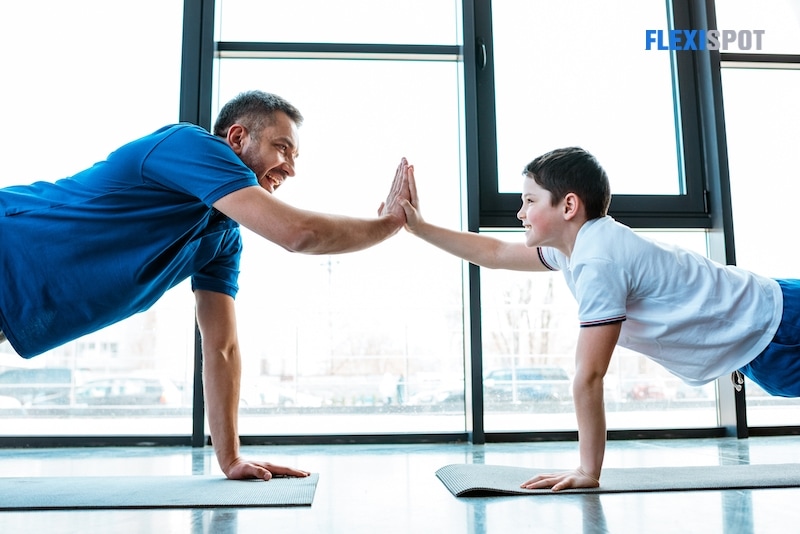Physical activity is an essential component of a healthy way of living for children. Schools can play a crucial role in encouraging students to participate in physical activity and play. It is beneficial to children's bodies. It promotes growth and development and should be encouraged for younger children throughout the day (ages 3 to 5). A minimum of 60 minutes of physical activity per day helps older children and adolescents develop strong bones and muscles, increase endurance, and maintain a healthy weight. There is growing evidence that moderate to vigorous physical activity improves children's critical thinking abilities, grade point averages, and regulated test scores.
What does regular physical activities in children influence?
Before we get into how you can encourage physical activity among schoolchildren, it's critical to understand why physical exercise should be a prime concern in the first place. Simply put, schools already have a lot to consider to assist students' cognitive and social success. It all boils down to a list of significant benefits — advantages that go beyond physical health. Physical activity, as per research compiled by the Centers for Disease Control and Prevention (CDC), is associated with improvements in:
Memory and Concentration
According to studies, physically fit children have larger ganglia and hippocampus capacities — parts of the brain involved in cognitive and memory development — than sedentary children. Focusing better in class and remembering more of what is taught can help children get the most out of their learning. Students can benefit from improved memory and attention in other aspects of life as well.
Mental Health
Mental health is an essential component of childhood development and, while it is a different matter worthy of its awareness, it tends to go together with physical well-being. Regular physical activity reduces the risk that children will experience anxiety or depression. Students' school performance can suffer as a result of mental health problems.
Attendance
Active students are less likely to be absent due to illness because physical exercise improves general health. Some students miss school due to stress, which physical activity can help to mitigate. Even as early as first grade, missing school can reveal an elevated risk of students dropping out. Attendance is essential for students to keep the momentum going in class and receive a thorough education.
Educational Fulfillment
In addition to the individual factors, there is a direct correlation between health and fitness and good grades. Higher academic achievement is a natural result of the numerous cognitive benefits students gain from physical activity. It is also true that physical exercise can result in higher grades in the short term. According to one study, children who were energetic 20 minutes before an exam performed better.
Class and School Behavior
Physical activity during the school day can also support learners in behaving better in the classroom. Listening, sitting still, and following directions can be difficult, especially with younger children. It can be crucial for children to behave when they are fidgety or sidetracked. Physical exercise satisfies students' need to move and play, allowing them to be adequately equipped to concentrate and listen in class. According to some studies, keeping the kids energetic can even help avoid bullying.
Keeping active as a child and teen can also prepare the students for a healthier adulthood. Regular physical activity assists students in developing muscular strength and endurance, improving cardio-respiratory fitness, maintain healthy body weight, and avoiding future diseases such as cardiovascular disease or type 2 diabetes.
How can we promote physical activities among kids?
Parents and teachers can play an important role in encouraging children to become more active and fit. Here are some ideas:
Consult Your Child's Doctor
Your child's doctor can explain the benefits of physical activity to them and can also assist you and your child in determining which sports or activities are best for your child.
Inform Parents and Students of Benefits
Encourage parents to restrict their children's time spent in front of a tv or computer screen and instead make plans for the entire family that involve physical activity, such as biking or trekking. Parents also might want to participate in extracurricular activities with their children to keep them energetic. We can empower students to stay active by educating them about the importance of exercise to their well-being, along with their academic performance. This is particularly important for older students because they can comprehend the studies on the benefits of regular physical activity and have much more control over how they spend their free time at home.
Plan Organized Activities
Adults or children can organize active play. There are active indoor games like Simon Says and plenty of outdoor games like jump rope, dodgeball, hopscotch, Frisbee golf, badminton, and volleyball. When applicable, plan trips to a local swimming pool, bowling alley, or skating rink, depending on the season.
Involve Them in Doing Chores
Motivate your children to help with active outdoor chores like pulling weeds, raking leaves, sweeping the walkways, watering plants, or cleaning the garage. Make chores more enjoyable by playing upbeat music and encouraging everyone to participate in completing them as a family.
Physical Activity in the Classroom
Teachers can create learning stations in each corner of the classroom and have students walk to each as part of the lesson. Even if teachers are hesitant to incorporate physical activity into their teaching methods, they can allow students to stand up every so often during class to stretch so they can refocus. Install standing desks, such as those from FlexiSpot, to help students manage fidgets and enable them to stand and move more easily and freely when needed, especially while in class.
Be an Active Role Model
Instead of viewing physical activity as a task, frame it as an important time to care for your health and body. Consider activities that you enjoy and engage in them for at least 30 minutes five days per week. When your kids see you having fun while being energetic, they are more likely to emulate your habits. When it comes to staying active, do your best to be a good role model. Teachers can explain to their students what they enjoy doing to stay active after school. Administrators can engage in school activity events hosted by your school.
Do Not Go Overboard
Physical activity should not be harmful. If the pain becomes unbearable, your child should slow it down or try a less strenuous activity. It is critical, as with any activity, not to overdo it. Consult your child's doctor if exercise starts to impede school or other practices.
Make time for activities for your children to engage in at least moderate-intensity physical activity per day, which can be divided up into smaller chunks throughout the day. Keep in mind to compliment, praise, and encourage them more physical exercises regularly.

